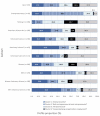Business Intentions of Australian Veterinary Students-My Business or Yours? A Cluster Analysis
- PMID: 37048481
- PMCID: PMC10092960
- DOI: 10.3390/ani13071225
Business Intentions of Australian Veterinary Students-My Business or Yours? A Cluster Analysis
Abstract
Little is known about veterinary entrepreneurial predisposition. Yet entrepreneurship and intrapreneurship (entrepreneurial behaviour of employees) foster business innovation and growth and support wealth creation and employment in both privately and corporately owned businesses which deliver contemporary veterinary services. We used responses from 515 final-year students in Australian entrepreneurship, nursing, and veterinary programs to capture entrepreneurial intention (EI), outcome expectations (OE-sb), entrepreneurial self-efficacy (ESE), and corporate/large organisation work intentions (CWIs). Veterinary respondents stood out for their high EI and high OE-sb, but low financial ESE and low CWI. Proportions of veterinary, entrepreneurship, and nursing respondents differed markedly across distinct cluster profiles representing entrepreneurial, intrapreneurial, both entrepreneurial and intrapreneurial, indifferent, and corporate employment intentions and attributes. Post hoc analysis revealed proportional cluster membership differences for respondents from different veterinary schools. Our findings raise questions regarding (1) the effectiveness of veterinary business curricula competencies which focus on expense management and (2) the implications of the mismatch of motivations and goals of new veterinary sector entrants whose low intent to work in a corporate environment is at odds with increasing corporate ownership of veterinary practices. To inform curricular change, we recommend further research to evaluate the relative impact of individual factors, admissions factors, and the formal or hidden curricula on entrepreneurial intention in veterinary final-year students.
Keywords: entrepreneurial intentions; entrepreneurship; field of study; identity; nursing; self-efficacy; students; veterinary.
Conflict of interest statement
The authors declare no conflict of interest.
Figures




Similar articles
-
How the New Type of Entrepreneurship Education Complements the Traditional One in Developing Entrepreneurial Competencies and Intention.Front Psychol. 2019 Sep 13;10:2048. doi: 10.3389/fpsyg.2019.02048. eCollection 2019. Front Psychol. 2019. PMID: 31572260 Free PMC article.
-
Predicting career sector intent and the theory of planned behaviour: survey findings from Australian veterinary science students.BMC Vet Res. 2019 Jan 15;15(1):27. doi: 10.1186/s12917-018-1725-4. BMC Vet Res. 2019. PMID: 30646904 Free PMC article.
-
Initial Validation of an Instrument for Measuring Entrepreneurial and Intrapreneurial Intentions in Student Pharmacists.Am J Pharm Educ. 2020 Jul;84(7):ajpe7624. doi: 10.5688/ajpe7624. Am J Pharm Educ. 2020. PMID: 32773822 Free PMC article.
-
Entrepreneurship in Nursing: an integrative literature review.Rev Bras Enferm. 2019 Feb;72(suppl 1):289-298. doi: 10.1590/0034-7167-2017-0523. Rev Bras Enferm. 2019. PMID: 30942375 Review. English, Portuguese.
-
Neither entrepreneurship nor intrapreneurship: a review of how to become an innovative split-off start-up.Front Sociol. 2023 Sep 25;8:1267706. doi: 10.3389/fsoc.2023.1267706. eCollection 2023. Front Sociol. 2023. PMID: 37818038 Free PMC article. Review.
References
-
- Board V.F.P. Taking Charge of Our Future: A Vision for the Veterinary Profession for 2030. Vet Futures; London, UK: 2015.
-
- Bok H.G.J., Teunissen P.W., Boerboom T.B.B., Rhind S.M., Baillie S., Tegzes J., Annandale H., Matthew S., Torgersen A., Hecker K.G., et al. International survey of veterinarians to assess the importance of competencies in professional practice and education. J. Am. Vet. Med. Assoc. 2014;245:906–913. doi: 10.2460/javma.245.8.906. - DOI - PubMed
-
- Henry C., editor. Veterinary Business and Enterprise. 1st ed. Elselvier; Edinburgh, UK: 2014. p. 176.
-
- Henry C., Treanor L. Exploring entrepreneurship education within veterinary medicine: Can it be taught? J. Small Bus. Enterp. Dev. 2012;19:484–499. doi: 10.1108/14626001211250171. - DOI
-
- Krueger N.F. Entrepreneurial Intentions Are Dead: Long Live Entrepreneurial Intentions. In: Brännback M., Carsrud A.L., editors. Revisiting the Entrepreneurial Mind: Inside the Black Box: An Expanded Edition. Springer International Publishing; Cham, Switzerland: 2017. pp. 13–34.
LinkOut - more resources
Full Text Sources

